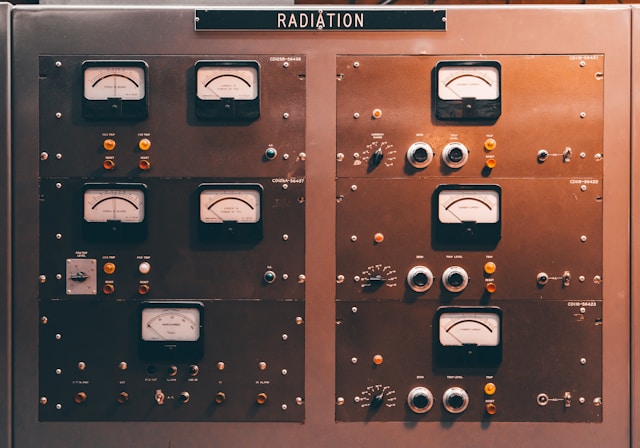ISAT 300 Semester Project
Measuring the Temperature of Harrisonburg and Examining Historical Data
Purpose
At its core, ISAT 300 is about, how we use data for informed decision making:
Over the course of the six lab experiments, you have applied fundamental measurement concepts during the collection and analysis of data.
The purpose of this laboratory exercise is to further our understanding of these fundamental measurement concepts, data acquisition, and data analysis techniques. These concepts are broadly applicable in many different arenas, but we will be focusing on ambient temperature measurements and discussing how they relate to global temperature measurements and the challenge of climate change.
Learning Goals
The goals of this project are to:
- Investigate and evaluate challenges and opportunities for measuring ambient temperature
- Understand how to setup and deploy a remote data logging instrument
- Be able to retrieve, analyze, and present data from a remote logging instrument across a range of platforms
- Describe the uncertainty associated with individual and multi-source temperature measurements for a given region
- Recognize how data acquisition has changed over time, specifically for global temperature measurements
- Acquire and analyze historical data from trusted sources to draw your own conclusions
- Report your findings in a formal lab report
Background
Global climate change has been described as the most challenging problem facing society. The Intergovernmental Panel on Climate Change (IPCC) was established in 1988 by the World Meteorological Organization and the United Nations to provide scientific assessments of climate change (who continue to provide funding for it). The IPCC has become the leading authority on Climate Change and provides broad public policy recommendations. It does not conduct independent research; instead, it conducts systematic reviews of relevant published data from the scientific community.
Since the First Assessment Report that was completed in 1990 and that predicted a rise of 0.3 \(^\circ\)C rise in global temperature per decade during the 21st century, the reports have become more comprehensive and have been increasingly focusing on the effects of warming and other global changes on humans and ecosystems alike.
The Fifth Assessment Report was completed in 2014. This report concludes that atmospheric CO2 concentrations increased to their highest levels of the past 800,000 years and that this will result in severe, pervasive, and irreversible impacts. Mean global temperatures will increase by 3.7 to 4.8 \(^\circ\)C by the year 2100. Mitigation strategies pledged in the Cancun agreements are likely (66-100%) to keep global temperature rise below 3 \(^\circ\)C.
The Sixth Assessment Report was completed in 2023. Results conclude that human-caused climate warming is certain and that limiting warming to below 1.5 \(^\circ\)C requires a 50% reduction in global climate warming gas emissions by 2050.
The 5th U.S. National Climate Assessment, published in 2023 by the U.S. Climate Research Program, summarizes climate change impacts, risks, and responses for the U.S.
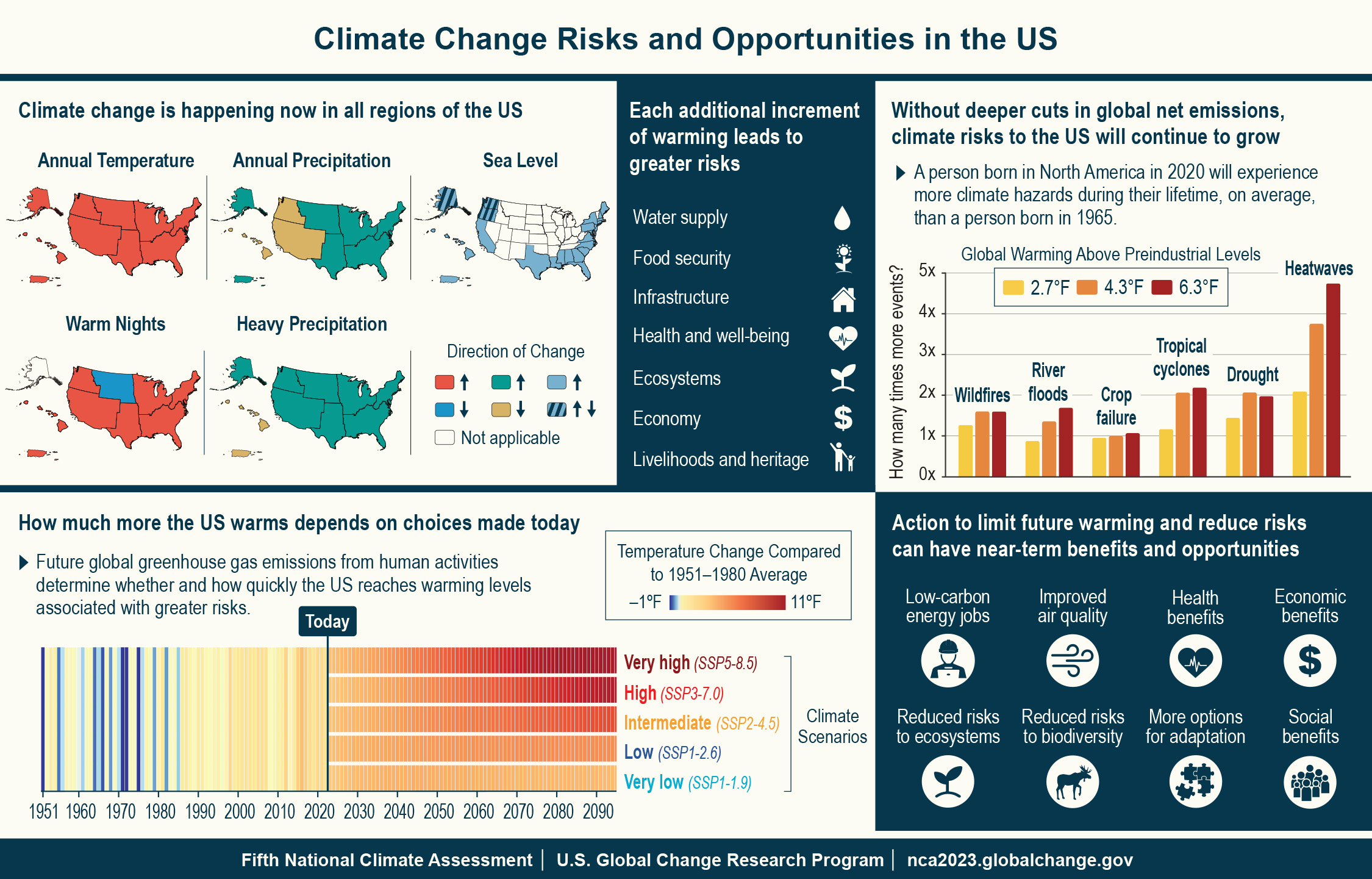
The 5th National Climate Assessment concludes that:
It is unequivocal that human activities have increased atmospheric levels of carbon dioxide and other greenhouse gases. It is also unequivocal that global average temperature has risen in response. Observed warming over the continental United States and Alaska is higher than the global average (virtually certain, very high confidence)1 . Long-term changes have been observed in many other aspects of the climate system (very high confidence). The Earth system is complex and interconnected, which means changes in faraway regions are virtually certain to affect the United States (very high confidence).
The change is climate is linked to increasing weather related disasters and strong changes in hot and cold extremes:
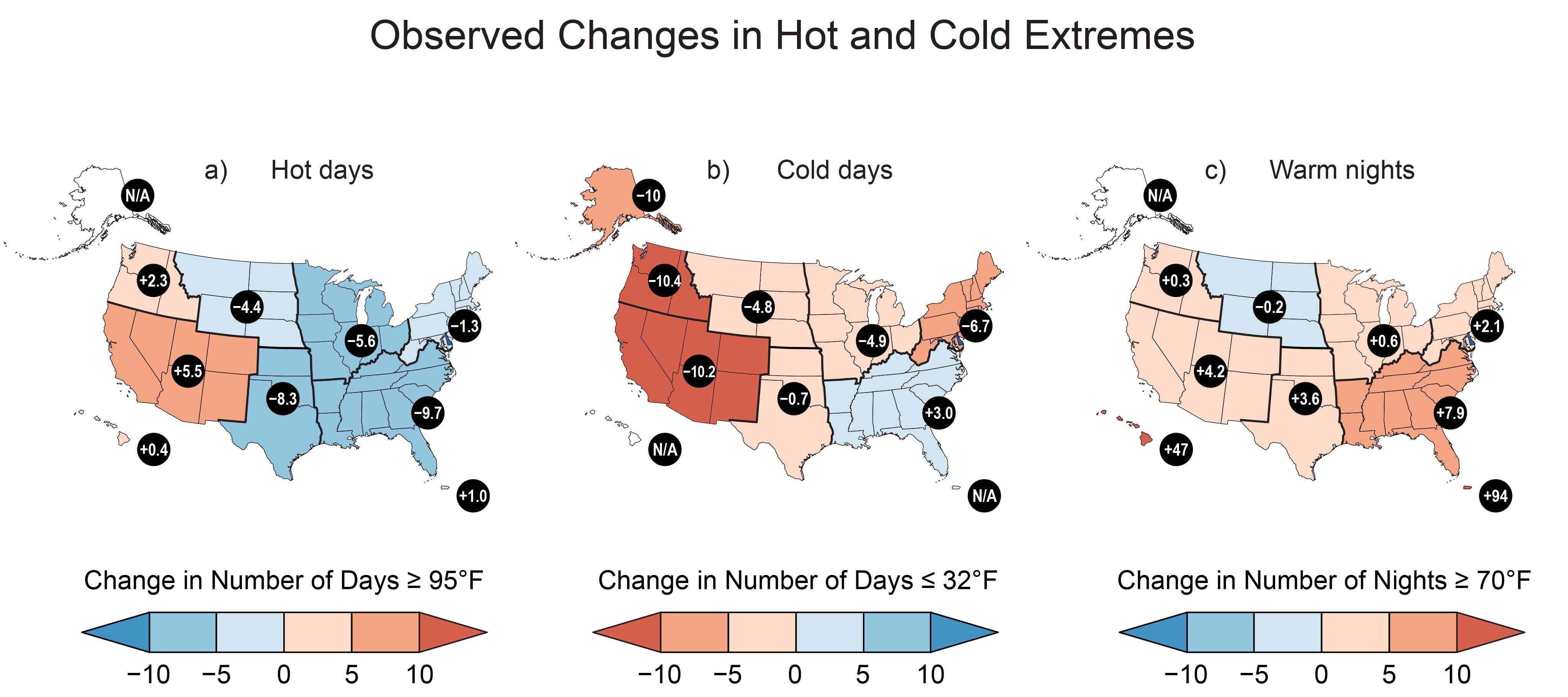
All these efforts to understand climate change, its impacts, and to model future climate variability are possible, because of climate and weather observations that are conducted all over the world.
More than 100,000 weather stations all over the globe are integrated into datasets that summarize how the climate has since the late 19th century:
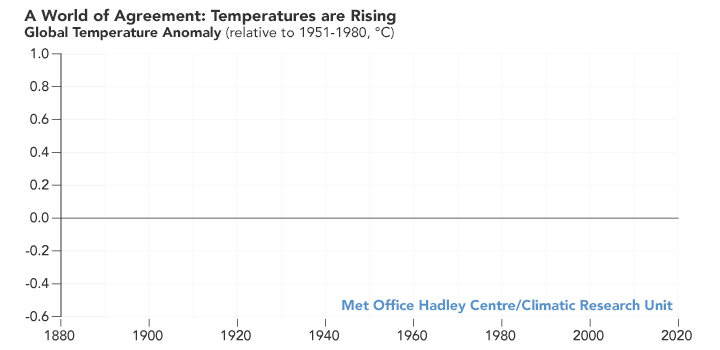
Think about what this means for the measurements:
- How can we ensure that observations are accurate and representative of global temperature?
- What are the uncertainties of the temperature record?
- How has climate changed locally?
Our semester project will address some of the questions.
Methods
Part I - Acquiring and analyzing temperature data in/ around Harrisonburg
To become more familiar with atmospheric air temperature measurements and the associated uncertainty, students will work in groups of two or three (2-3) to embark on long-term remote data logging of surface air temperature in and around Harrisonburg, Virginia. Each student team will be provided with Onset HOBO MX2201 Temperature data loggers capable of storing 98,000 measurements. They will be responsible for the initialization, activation, and deployment of these sensors.
You will need to follow the manufacturer’s instructions for the initial setup of the data logger before deployment. This includes the installation of the HOBOConnect App on either a computer or cell phone. You may also find it helpful to use HOBOLink and HOBOWare to process and visualize data.
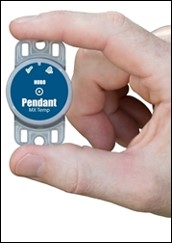
The MX2201 is a small, waterproof temperature data logger capable of storing 98,000 measurements. It connects wirelessly via Bluetooth to cellphones or computers using the HOBOConnect App. The HOBOConnect App will be necessary for initializing the data logger before deployment, setting operational parameters, and downloading data that has been acquired. The HOBOLink website can be used for more extensive data visualization and management, as well as exporting data to different file types for analysis with other software packages.
The HOBOConnect App is required to initialize the temperature data logger. Your Team will need to decide how you want to set up the logger – including the sampling rate, Bluetooth, and security settings.
Test the datalogger before you deploy it! You must be able to record, view, and download data from your MX2201 sensor before you launch your data acquisition.
Your Team will determine where to place the datalogger for ambient air temperature readings. Avoid placing the datalogger in locations where it is likely to be picked up by someone (i.e. – groundskeepers will likely find it if not well hidden).
Please keep in mind that you are responsible for the sensor
Teams will be asked to report data from the Logger regularly. Your group must be able to access the data you have logged with your sensor. The HOBOConnect App is necessary to interact with the sensor and download data. It can also create graphs and export data to a variety of file formats (if you would prefer to use Excel to make your graphs, for example). The HOBOConnect App will only store data locally, so you must have the device with you in class to report out.
You will also create a free account on the HOBOLink website. Once set up, every time you download data with HOBOConnect, it will also be uploaded to the HOBOLink website, where it can be viewed on any device at any time.
In the final lab writeup, you must provide an estimate of the uncertainty in your measurements and conclude whether or not the class was able to accurately measure the air temperature in Harrisonburg.
Methods - Part II: Analyzing Historical Temperature Data
In addition to directly measuring temperature in/around Harrisonburg, your Team will need to evaluate historical temperature data for evidence of global warming.
The dataset that we will be using is daily weather data observed with a long-running weather station at Dale Enterprise, VA. Dale Enterprise is the closest official weather station in the dataset to JMU and happens to have one of the longest temperature records in the U.S.
In fact, it is the 3rd oldest weather station in the U.S and it is privately owned by a local family.
It is part of NOAA’s Global Historic Climatology Network Daily dataset, which contains recorsd of “100,000 stations in 180 countries and territories” (NOAA GHCNd)
You can see in the figure below, that data is being recorded since 1893!
If you go to the station website, you can not only see, what weather variables are being recorded, but also download the data and find information about station history, such as instrument and location changes … Such information is called meta data and can provide important context for interpreting the data.
Expectations
This activity is different from many other lab experiences you may have had, specifically because your team is operating independently of other students and you are conducting experiments outside the lab. Rather than follow a scripted cookbook style experiment, you will need to make decisions about how to obtain your measurements, how to analyze the data, and what conclusions can be drawn. All of these concepts are covered in this class, but here you are being asked to apply them.
All students are responsible for engaging with their temperature measurements every week, to ensure everything is working properly, and to make any necessary adjustments to improve performance. Enough data should be taken such that you can report a Mean Value \(\pm\) Uncertainty. Your Uncertainty Analysis should include insight from the manufacturer’s specifications regarding the sensor, calibrations, and your measurements.
Data should be presented in the most effective means possible. This will include charts, tables, and graphs. Be sure to include figure legends and to discuss the figures in the text. Where appropriate, include correlation coefficients (R2 values), and statistical analyses (descriptive statistics, t-test, p-values). You will need to do this for the temperature measurements YOU take around Harrisonburg AND for the National Weather Service and NOAA data you download.
Your final conclusions must be based on the data!
Do not simply agree with other’s analysis or things you have read/heard about regarding climate change. The goal of this project is for you to be able to analyze data independently from other entities and draw defensible conclusions based on your analysis. It is perfectly reasonable to anticipate your analysis to align with your expectations and to show evidence of global warming consistent with the IPCC reports.
At the same time, your analysis might show something different, and that is OK so long as your conclusions accurately reflect what is revealed in the data you analyzed. We are not trying to prove or disprove global warming and climate change in general, the science is already clear on this. Our goal is to make an unbiased, scientific evaluation of the local data, including its uncertainty, and to make our own conclusions based on what the analysis shows.
Semester Project Deliverables
1. Your Report
Even though this is not strictly a lab report, please refer to How To Write A Lab Report (link also on Canvas) for relevant information in each section.
Your report needs to contain the following components
- Abstract (5% of total grade)
- Introduction with Background (20%)
- Provide background information on climate change. Describe the problem and why it is important.
- Explain the concept of climate normals and why they are needed for climate data analysis
- Include figures where appropriate
- Reference outside material.
- Relate measurements and specifically temperature measurements to understanding climate and climate change
- Provide background on the HOBO logger you have been using (see resources)
- Provide background on the Dale Enterprise Weather Station. What is special about it?
- Describe how data from observations can be used for decision-making regarding climate change
- Describe the specific research objectives of your report.
- Do not describe what you are learning in the lab
- Describe what questions you are investigating using your data
- Identify your hypotheses about your data
- You must reference your sources in-text and must use outside sources for your report.
- Look at your results and analysis and think about what a smart - but not expert - reader would need to know to make sense of it.
- Methods (10 %)
- Describe where (pictures and coordinates) and how the data used in this report was collected (your data and the provided weather station data).
- Include Maps and Photos where appropriate.
- Describe the HOBO sensor and reference its spec sheet (see resources).
- Describe how you processed the data: What did you calculate? And how did you do so?
- Someone familiar with weather and climate data should be capable of doing the same analysis based on your description.
- Describe where (pictures and coordinates) and how the data used in this report was collected (your data and the provided weather station data).
- Results (25%)
- Your results section should tell the story of the data that (1) you collected and (2) the data you analyzed from NOAA.
- You can include as many figures and tables as you like.
- At the minimum, your results section should include the following:
- A figure showing the temperature trend at Dale Enterprises for the entire period (1893 to 2024)
- Histograms of minimum and maximum temperatures.
- Each group is assigned a historical 30-year period (e.g. 1901 to 1930, or 1951 to 1980) for a more detailed analysis.
- Make figures showing the year-to-year variability of daily minimum and maximum temperatures for March.
- Your figures should have the day on the x-axis and temperature on the y-axis.
- Add each year as a line.
- Add mean and standard deviation to the figure as well (using a contrasting color).
- We will discuss/ have discussed this in class.
- Conduct a statistical analysis to determine whether there was a significant temperature change between your assigned 30-year period and the current (1990-2020) climate normal period.
- To do so, you will need to conduct a paired t-Test (see resources)
- A figure containing your data from the HOBO loggers.
- A figure showing the correlation between your HOBO data and the corresponding station.
- Indicate R2 in the figure.
- A figure showing the daily cycle of temperature data (including average and uncertainty) using your HOBO data.
- A figure comparing your data to the average climate data for Harrisonburg
- All figures and tables must be added to the report with a descriptive caption (figures) or header (tables) that helps the reader understand what is displayed
- All figures must also be briefly described within your Results section.
- Analysis/ Discussion (20%)
- Provide analysis of the figures. Your analysis section should reference all figures and tables in the results section (again) and link back to the specified research questions. Make sure that you address the research questions posed in the introduction.
- Based on your analysis discuss
- Is there evidence for temperature change?
- Compare inter-annual variability to the temperature change that has happened between your assigned 30-year period and today’s climate (1990-2020)
- What does this mean for understanding local and global warming?
- Discuss the representativeness of your data and how this relates to understanding local and global temperature change.
- Is the data you worked with normally distributed or is there evidence for skewness?
- What is the role of uncertainty in the data you analyzed (and climate changge in general)?
- How does the data fit into the context of local and global climate change?
- How the data and your analysis specifically could be used for decision-making.
- What are the limitations?
- What else would be needed?
- Anything else you find interesting or useful about the data and how it relates to climate change or ISAT 300 in general.
- Your analysis should be grounded in your own results. If your analysis contradicts your initial hypothesis or expectations do not change your analysis, but discuss potential reasons for disagreement.
- Conclusion (10%)
- What are the main takeaways from your analysis?
- Whether they support your hypotheses
- How do your takeaways relate to the background of climate change and measurements as a whole (i.e. this class)?
- References (5%)
2. A 5-minute Presentation
- Each group should do a 5-minute presentation about their analysis. Each team member should contribute to the presentation. You may present in class, or you may submit a video of your presentation to be shown in class.
- The presentation should include:
- Outline your research questions and state your hypotheses
- Present the data you collected using the HOBO loggers.
- Is your data representative? Why/Why not?
- Is there evidence for change in your data based on the 30-year periods?
- 2 additional Key takeaways from your analysis (you can be creative if you want to).
- If money or time would not be an issue, what additional experiment or analysis would you do?
3. Supporting Information
- A CSV File Containing the HOBO-Data
- A file (Excel, Python, …) containing your data processing
| Revision | Description | Author |
|---|---|---|
| 2025-03-20 (S25) | Updates and reframing of introduction | Tobias Gerken |
| (S24) | Updated to Web and change of deliverables | Tobias Gerken |
| Initial Version | Chris Bachmann |
Footnotes
The 5th National Climate Assessment considers a likelihood of >99% as virtually certain and assigns very high confidence to findings with “Strong evidence (established theory, multiple sources, well-documented and accepted methods, etc.)” and “High Consensus”.↩︎
